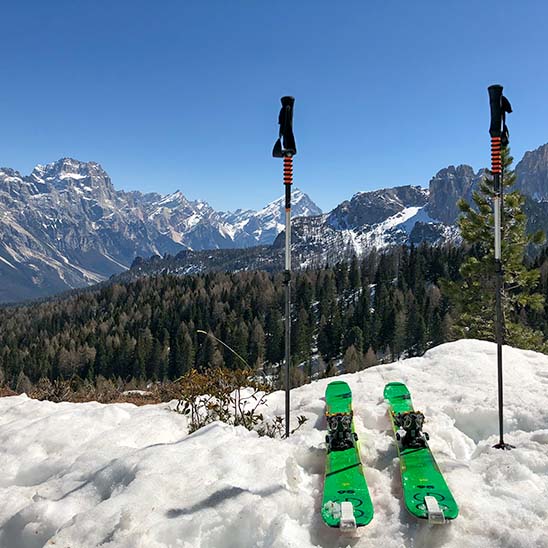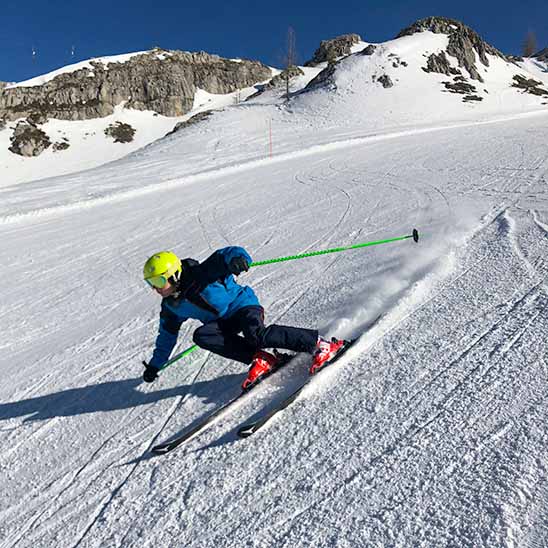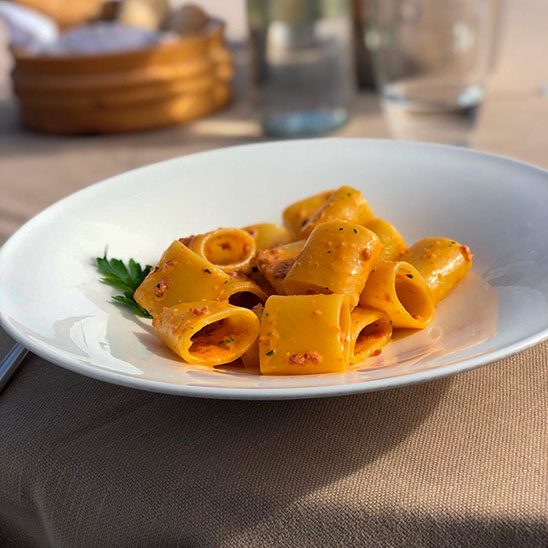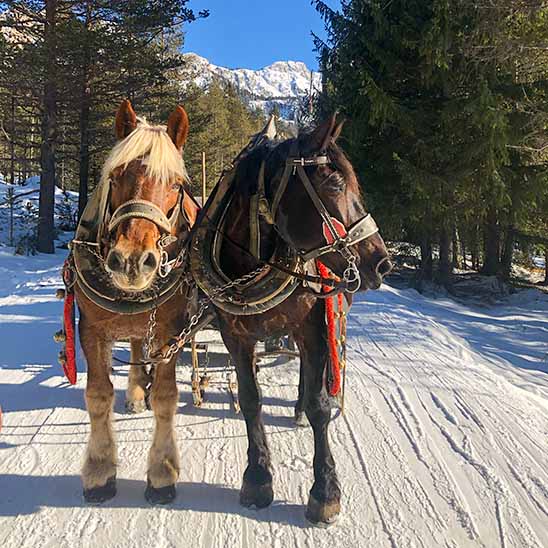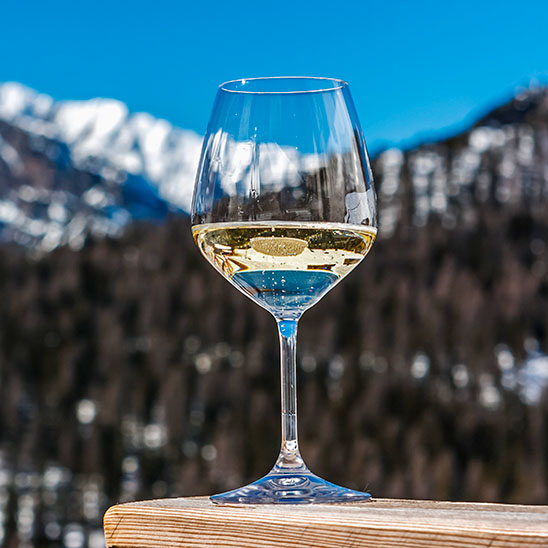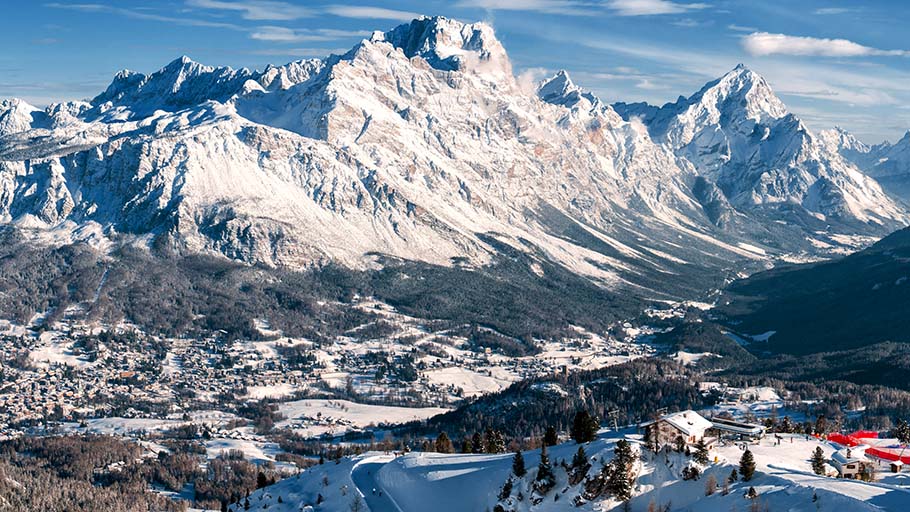
Table of Contents
- A Storied Past and Geographical Splendor
- A Panorama of Peaks and Water Bodies
- Climate: A Blend of Oceanic and Continental
- Origins of the Name
- Cortina d’Ampezzo Tourism History
- The 1956 Winter Olympics
- Historic Military Architectures in Cortina d’Ampezzo
- Ampezzo Dolomites Regional Natural Park
- Cinematic Cortina d’Ampezzo
- Literary Mentions of Cortina d’Ampezzo
- Cortina d’Ampezzo’s Gastronomy
- Cortina d’Ampezzo Skiing
- Cortina d’Ampezzo’s Sports Legacy
- Cortina d’Ampezzo: A Haven for Fashion Enthusiasts
- Conclusion
Cortina d’Ampezzo is a charming Italian town located in the province of Belluno, Veneto. It has a population of about 5,537 people and is known locally as Anpezo or Hayden. The city is situated in the historical and geographical region of Ladinia and is a bustling hub for both residents and visitors alike.
A Storied Past and Geographical Splendor
Cortina d’Ampezzo has a rich history as a host of international mountain sports events. Notably, it was the venue for the 1956 Winter Olympics and the Alpine Ski World Championships in 1932, 1941 (later canceled), and most recently in 2021.
The geographical location of Cortina is nothing short of spectacular. It sits at the heart of the Ampezzo Valley, within the high Boite River Valley. This was once the terminal basin of an ancient Quaternary glacier. It has now given way to a stunning landscape that spans 252.81 km², making Cortina the third-largest commune in Veneto.
The regional park of Dolomiti d’Ampezzo showcases geological formations dating back to the Mesozoic era, primarily composed of sedimentary rocks such as dolomite and limestone.
A Panorama of Peaks and Water Bodies
The awe-inspiring Dolomites, part of the Eastern Alps, surround Cortina d’Ampezzo. These mountains lend an unparalleled beauty to the valley. Among the most famous are the Tofane to the west, Pomagagnon to the north, Cristallo to the northeast, Faloria and Sorapiss to the east, and Becco di Mezzodì, Croda da Lago, and Nuvolau group to the south.
The commune is abundant in water sources. The Boite River flows through the town, with numerous tributaries descending from the mountains. The Fanes River is another significant water body known for its stunning waterfalls. Small alpine lakes, formed either naturally or artificially, add to the picturesque landscape of Cortina.
Climate: A Blend of Oceanic and Continental
Cortina enjoys an intermediate climate, a blend of oceanic and continental. Summers are relatively cool, while winters are long and harsh. Over 30 years, the average summer temperature was found to be around 15.4°C, dropping to -2.5°C in January, the coldest month.
Origins of the Name
According to scholars, the toponym “Ampezzo” has Latin roots, possibly meaning “near the fir” or “open and spacious place.” Another theory suggests a pre-Latin root related to wild plants and fermenting liquids. The word “Cortina” is believed to come from the diminutive of “curtis,” indicating small territorial units. The first mention of Ampezzo dates back to 1156, and the combination of the names “Curtina ampitii” is found in a document from 1317.
Cortina d’Ampezzo, nestled in the heart of the Dolomites, boasts a captivating history that spans centuries. Its ancient origins trace back to the Roman Empire, where it served as a strategic outpost defending against barbarian invasions. Over time, the town evolved, witnessing the ebb and flow of historical events that shaped its identity.
Cortina d’Ampezzo Tourism History
In the 19th century, Cortina d’Ampezzo experienced a golden age of tourism, attracting visitors with its breathtaking alpine beauty and charming atmosphere. However, this prosperity was interrupted by the outbreak of World War I, when the town became occupied by military forces. Eventually, Cortina d’Ampezzo was peacefully annexed by Italy, becoming an integral part of the country.
The Great Depression brought economic challenges to the town, but Cortina d’Ampezzo’s indomitable spirit prevailed. As the 1930s unfolded, the rise of tourism once again breathed life into the region, revitalizing its economy and bringing renewed hope to its inhabitants. However, this period was not without its struggles, as fascist policies sought to Italianize the area, posing challenges to its cultural heritage.
During World War II, Cortina d’Ampezzo fell under German occupation, enduring the hardships of war. Yet, the town’s resilience shone through as it became a hub of resistance and liberation. Partisans and American troops played a pivotal role in liberating Cortina d’Ampezzo, marking a turning point in its history.
Today, Cortina d’Ampezzo stands as a testament to its extraordinary past. Its captivating landscapes, rich heritage, and vibrant culture continue to fascinate visitors and serve as a reminder of the town’s historical significance.
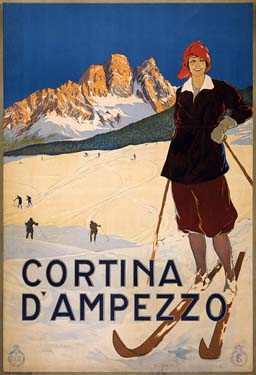
The 1956 Winter Olympics
The VII Winter Olympic Games were originally planned for 1944 but were postponed due to World War II. Eventually, Cortina d’Ampezzo in Italy was chosen to host the games in 1956. The organizers faced significant challenges in preparing the sports facilities and improving infrastructure. The Olympics were a success, with participants from 32 nations and notable performances by athletes like Toni Sailer from Austria. Italian athletes also achieved success, winning three medals. The games brought significant tourism and economic growth to Ampezzo, marking the beginning of a new era for the town.

Historic Military Architectures in Cortina d’Ampezzo
Cortina d’Ampezzo, with its storied past, is home to numerous historical military architectures that serve as silent witnesses to the town’s eventful history. The most important are:
- Forte Tre Sassi: Austro-Hungarian fortress near Passo Valparola, South Tyrol. Now houses a Great War Museum.
- Botestagno Castle: Medieval fortress in the Boite River valley. Ruins date back to the 11th century.
- De Zanna Castle: Small, unfinished fortress with a unique story from the late 17th century.
- Pocol Military Shrine: Funerary monument commemorating casualties of the Great War on the Dolomite front, including General Antonio Cantore.

Ampezzo Dolomites Regional Natural Park
Located in the heart of Ampezzo town, the Ampezzo Dolomites Regional Natural Park extends north of Cortina d’Ampezzo to the border of Trentino-Alto Adige. It seamlessly integrates with the Fanes – Sennes – Braies Natural Park, creating an extensive naturalistic area with similar features, covering approximately 37,000 ha. The park, established on March 22, 1990, covers a total area of 11,200 ha. The Community of the Rules of Ampezzo manages it on behalf of the Veneto Region.
The park encompasses famous Dolomite groups such as Cristallo, Tofane, Fanes Summit, Col Bechei, and Croda Rossa, divided by Val Travenanzes, Val di Fanes, high Boite Valley, and Val Felizon. Some of these massifs have peaks exceeding 3,200 meters and small glaciers on their northern slopes. The park’s entrance is located at the confluence of the valleys, which form spectacular natural gorges. Beyond these gorges, you can find vast grazing plateaus situated at high altitudes. The Falzarego River Valley borders the park to the west and Val Padeon to the east. The park has nineteen tourist facilities, including restaurants and alpine huts.
Cinematic Cortina d’Ampezzo
Due to their stunning natural landscapes, directors and screenwriters have chosen Cortina d’Ampezzo’s sublime mountains and valleys as perfect film sets. For instance, the American movie “Cliffhanger” (1993), directed by Renny Harlin and starring Sylvester Stallone, was filmed in Ampezzo, specifically the slopes of Lagazuoi, despite the story being set in the Rocky Mountains.
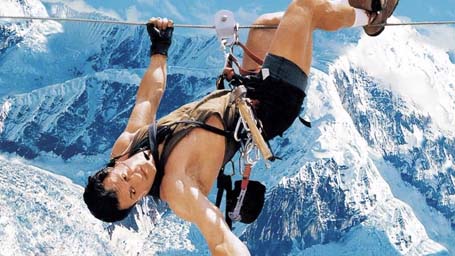
Another example is the British adventure film “Campbell’s Kingdom” (1956), which used Fiames and the surrounding area of Cortina d’Ampezzo as a filming location, even though the setting was Alberta, Canada. Other internationally acclaimed films shot in Ampezzo include “The Pink Panther” (1963), “Ash Wednesday” (1973), “For Your Eyes Only” (1981), “Von Ryan’s Express” (1965), “L’Ours” (1988), “Ladyhawke” (1985), and “The Great Silence” (1968). Cortina d’Ampezzo and its valley also made a brief appearance in the film “Spider-Man: Far from Home,” although the location was mistakenly referred to as Austria instead of Italy.

Literary Mentions of Cortina d’Ampezzo
Cortina d’Ampezzo has left its mark in both film and literature. Renowned authors Aldous Huxley and Ernest Hemingway mention the town in their works. Huxley refers to it in his essay “The Doors of Perception,” recounting his experiences with mescaline. In “A Moveable Feast,” Hemingway mentions that his first son was conceived there. These literary references highlight the enduring allure and romantic charm of Cortina d’Ampezzo.
Cortina d’Ampezzo’s Gastronomy
Cortina d’Ampezzo’s cuisine reflects its strong ties with Western Austria, seen in the similarity of dishes and their traditional German names. Rooted in local tradition, the food is modest yet flavorful, showcasing heritage.
Famous dishes include “chenedi” (local Tyrolean dumplings) breadcrumb-stuffed balls served in broth or melted butter. Another renowned dish is “Casunziei,” half-moon ravioli stuffed with beetroot or potato. The Austrian influence is evident in Gulaschsüppe, a spiced meat soup.
Mushroom roast, “gröstl” (meat and potato cake), pork ribs, game stews, cured meats, and sausages are common. Side dishes include “Ampezzo potatoes.” The local cheese “zigar” is often served melted with polenta.
Desserts include apple strudel, “fartaies,” and a ricotta tart. Austrian desserts like “krapfen,” “nighele,” and “Sacher Torte” are also popular. Preserves made from berries and local honey, particularly multi-floral and rhododendron honey, are noteworthy.
Cortina d’Ampezzo’s cuisine is a blend of flavors, traditions, and influences that enhance the place’s unique charm. The dining experience in this town is as diverse and enjoyable as the skiing and other activities it is known for.

Cortina d’Ampezzo Skiing
Cortina d’Ampezzo, renowned as a world-class skiing destination, owes much of its infrastructure to the facilities constructed for the Olympic Games. The town boasts over thirty ski lifts, including four cable cars, over twenty chairlifts, and around ten T-bars. The ski routes are predominantly concentrated in the Tofana area, the Cortina Cube (Mietres – Cristallo – Faloria), and the Cinque Torri – Col Gallina – Lagazuoi ski areas.
Cortina d’Ampezzo, known as Olimpia Superski, is a part of the expansive Italian Dolomiti Superski area, recognized as one of the world’s most extensive ski carousels. The resort offers more than eighty downhill ski slopes, covering a total distance of over 140 km. For cross-country skiing enthusiasts, there are a total of 58 km of trails, particularly in the Fiames locality and along the renowned Dolomite Cycle Path. This impressive array of facilities and routes solidifies the popularity of Cortina ski, further enhancing the town’s allure as a winter sports destination.
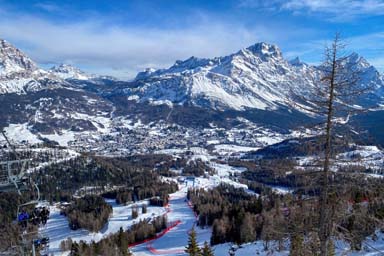
Cortina d’Ampezzo’s Sports Legacy
Cortina d’Ampezzo has a rich history of hosting prestigious international sporting events, particularly winter sports. Here, the most important:
- Nordic Skiing World Championships in 1927.
- Alpine Skiing World Championships in 1932 and 2021.
- Two Men Bobsleigh World Championships in 1937.
- Four Men Bobsleigh World Championships in 1939.
- Nordic and Alpine Skiing World Championships were planned for 1941 but were later canceled.
- Bobsleigh World Championships in 1950, 1954, 1960, 1966, 1981, 1989 and 1999.
- Winter Olympic Games in 1956, including Nordic, Alpine Skiing, Ice Hockey World Championships, and European Ice Hockey Championships.
- Figure Skating World Championships in 1963.
- Curling World Championships in 2010.
- Upcoming host of XXV Winter Olympic Games in 2026, in collaboration with Milan.
Cortina d’Ampezzo: A Haven for Fashion Enthusiasts
Nestled in the picturesque landscape of Cortina d’Ampezzo, this charming town exudes an irresistible air of sophistication and glamour. As you stroll down its elegant streets, you’ll be captivated by the exquisite high-end boutiques that line the way, beckoning fashion lovers to indulge in a shopping spree like no other.
But it’s not just about fashion. Cortina d’Ampezzo is also renowned for its luxurious hotels that offer the perfect blend of luxury and comfort. From lavish suites with breathtaking views to impeccable service that caters to your every need, these hotels are a haven for those seeking a truly indulgent getaway.
And let’s not forget about the gastronomic delights that await you in this culinary paradise. Delve into the world of local cuisine as you savor the region’s flavors at the various top-notch restaurants that dot the town. From traditional dishes bursting with authentic flavors to innovative creations that push the boundaries of gastronomy, Cortina d’Ampezzo promises to tantalize your taste buds most extraordinarily.
So, whether you’re a fashion enthusiast, a luxury seeker, or a food lover, Cortina d’Ampezzo has it all. Immerse yourself in the glamour and gastronomy of this enchanting town, and let it weave its magic around you.
Conclusion
Nestled in the heart of the Italian Dolomites, Cortina d’Ampezzo is a picturesque town that boasts a rich history, stunning natural beauty, and a vibrant cultural scene. With its breathtaking mountain views, crystal-clear lakes, and lush forests, Cortina is an ideal destination for nature lovers looking to escape the hustle and bustle of city life.
But Cortina is more than just a nature lover’s paradise. The town is also renowned for its luxury accommodations, high-end shopping, and world-class dining. Whether you’re looking to indulge in a spa treatment, shop for designer fashion, or savor a gourmet meal, Cortina has something to offer every kind of traveler.
Furthermore, Cortina is a treasure trove of fascinating landmarks and attractions for those interested in history and culture. From the WWI buildings to the iconic bell tower in the town square, Cortina is steeped in history and tradition.
In short, Cortina d’Ampezzo is a must-visit destination that offers a unique blend of nature, luxury, culture, and history. So whether you’re an adrenaline junkie, a culture buff, or simply seeking a relaxing getaway, Cortina has something for everyone to enjoy.
